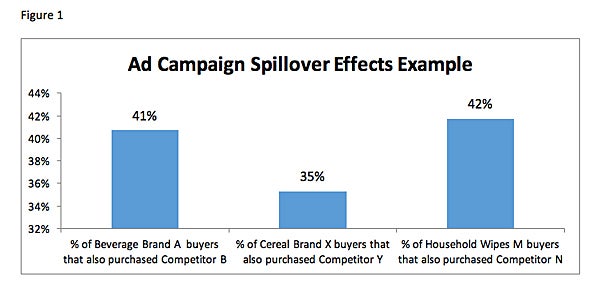 “Data-Driven Thinking” is written by members of the media community and contains fresh ideas on the digital revolution in media.
“Data-Driven Thinking” is written by members of the media community and contains fresh ideas on the digital revolution in media.
Today’s column is written by Vijoy Gopalakrishnan, senior vice president and principal at the IRI Media Center of Excellence.
While advertisers should always measure the sales lift of the products they advertise, sometimes they may also want to get a read on complementary products – the halos – as well as the category and, at the extreme, their competitors.
For example, maybe I saw an ad for Pepsi Wild Cherry, which influenced me to visit a store. However, at the store, I buy Pepsi Zero, which is what I normally buy. The Pepsi Wild Cherry ad activated that decision. Or maybe a potato chips ad activated my decision to visit the store, but I bought store-label chips, which you could consider a competitor.
But, if the ad is only related to the target brand, interpreting halo/category/competitor lift becomes difficult because we don’t know if the measured lift is due to random noise or real purchase behavior change resulting from the ad. That is an important distinction that advertisers must address to avoid or limit false negative and false positive errors.
How to solve for this conundrum? The one area where we can assume minimal effect of random noise is if we can demonstrate that the target product and halo products are purchased together often and the category and competitor brands are substitutable for the target brand.
Cross-purchasing and substitutability
There are two strategies endemic to any ad campaign that affect targeting and measurement. Strategy one: Minimize driving traffic to competitors. Strategy two: Measure any spillover – the percentage of consumers who switch from the target brand to substitutes.
Analyzing substitutability is important for both strategies. One way to operationalize substitutability is to conduct a basket analysis and confirm if there is cross-purchase behavior taking place between the target brand in the ad and the other products you are measuring. This will help you assess the potential for spillover.
For example, consider a comparison between Tide laundry detergent and Kirkland laundry detergent from Costco’s private label. If an analysis shows that in the past 52 weeks consumers switched between Tide and Kirkland more than 25% of the time, we would deem the Tide and Kirkland laundry detergents to be substitutable. Therefore, an ad for Tide has some empirical basis to assume a boost for Kirkland laundry detergent purchases.
Or if Tide makes up 40% of the subcategory in market share, then you could measure lift from a Tide ad campaign to gauge possible spillover effects to other laundry detergent brands.
Figure 1 shows the cross-purchase behavior for three brands in the beverage, cleaning and breakfast categories. For example, 41% of households that purchased Brand A also purchased the same product type from Competitor B. This could be because of different preferences within the household or price sensitivity, leading to switching between brands during promotions. Recognizing cross-purchase behavior can help CPGs target messaging that minimizes spillover effects. Targeted promotions tied to purchase cycles, for instance, can help minimize substitutions by price-conscious consumers and shore up the target brand’s market share.
Figure 2 shows the impact of a target brand’s ad campaign on competitor and category sales. Since the lift analysis showed that sales for the category and competitor were higher than for the target product after the ad campaign, there is clearly an opportunity to improve execution.
Prescriptive analysis
Based on these results, brands would want to perform a prescriptive analysis to avoid driving traffic to competitors.
Perhaps the substitutability of the brand had an unintended knock-on spillover effect to competitors. If the brand was aware of this nuance, advertisers could tweak the creative as a first step to strengthen the value proposition.
Did the campaign target loyalists, competitors or use a plain vanilla demographic targeting approach? Since brands have the least control over demographic targeting, it is critical to focus on actual behavior, such as purchase-based targeting.
Or, if the brand wants to measure spillover effects, then a cross-purchase analysis is all that is needed.
This could be an acceptable approach if a brand dominates category market share. In this case, you would expect some spillover effect and, even better, halo effects on other brands – think Pepsi’s halo effect on Lays potato chips – but it should be studied and benchmarked to help hone future marketing strategies.
Targeting and measurement include copious amounts of science and a dash of art. One analogy is adding salt to soup. Yes, the main focus of a campaign is to retain or capture market share – the soup – but the art – the salt – lies in knowing a brand’s market share in the category and messaging or promoting accordingly. Promote too hard and you erode brand value; promote too lightly and you lose market share. But study purchase behavior and intervene at the right time, and the salt is magic.
Just as with soup, brands should conduct their prescriptive analyses to measure halo effects – and don’t forget to add the salt.
Follow IRI (@iriworldwide) and AdExchanger (@adexchanger) on Twitter.














